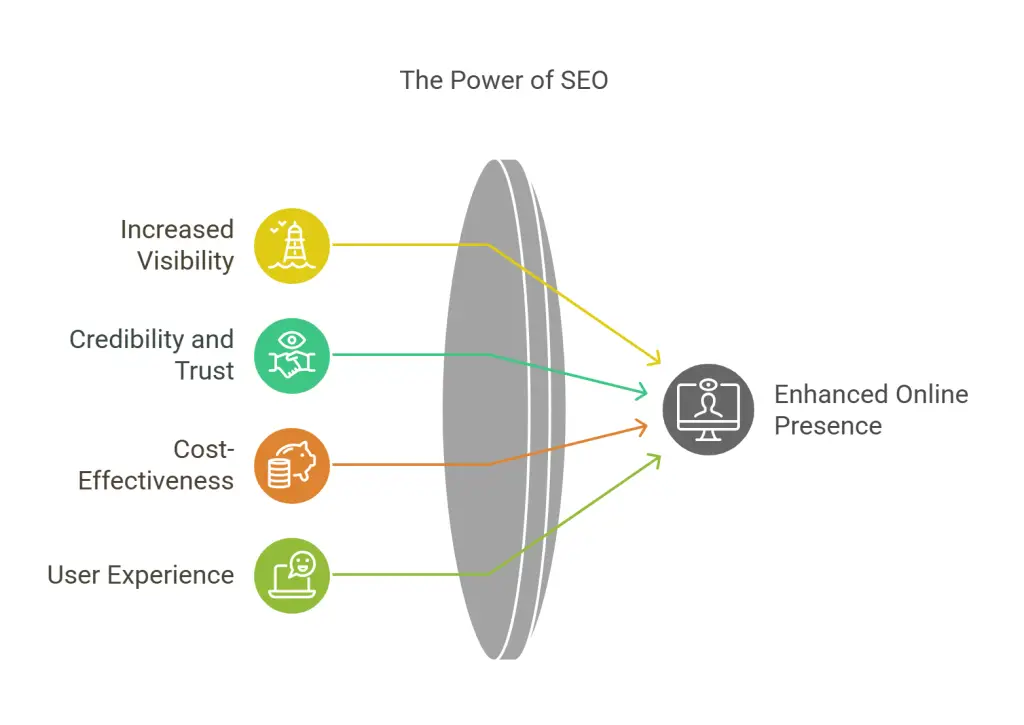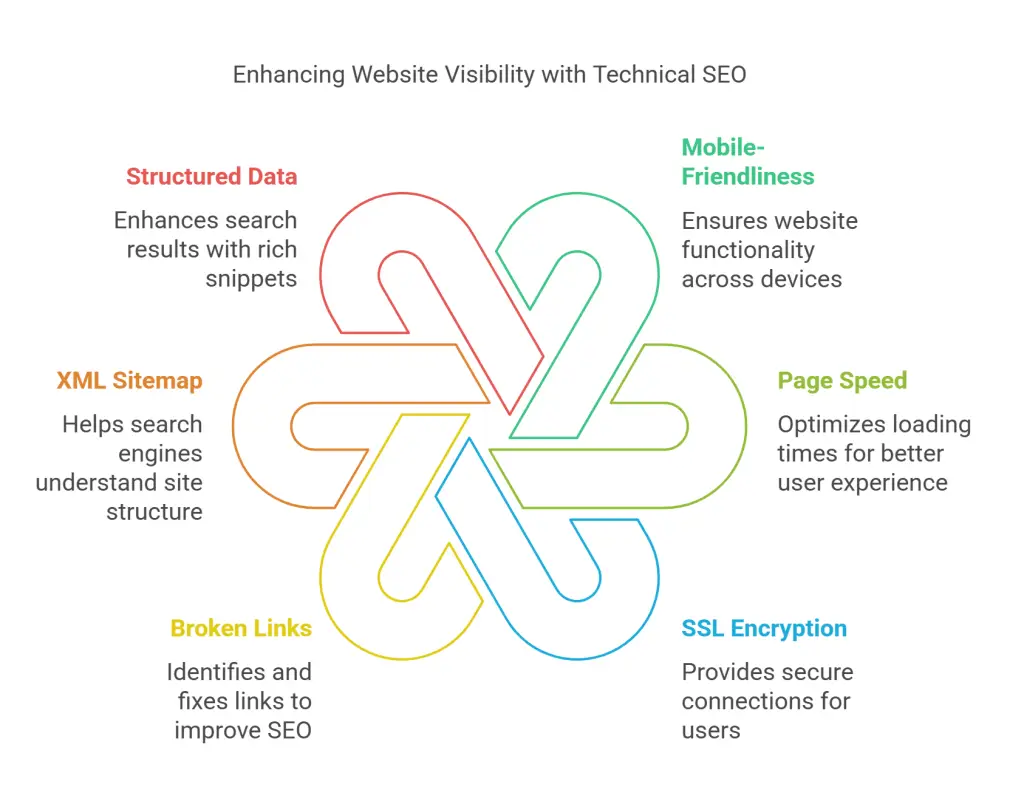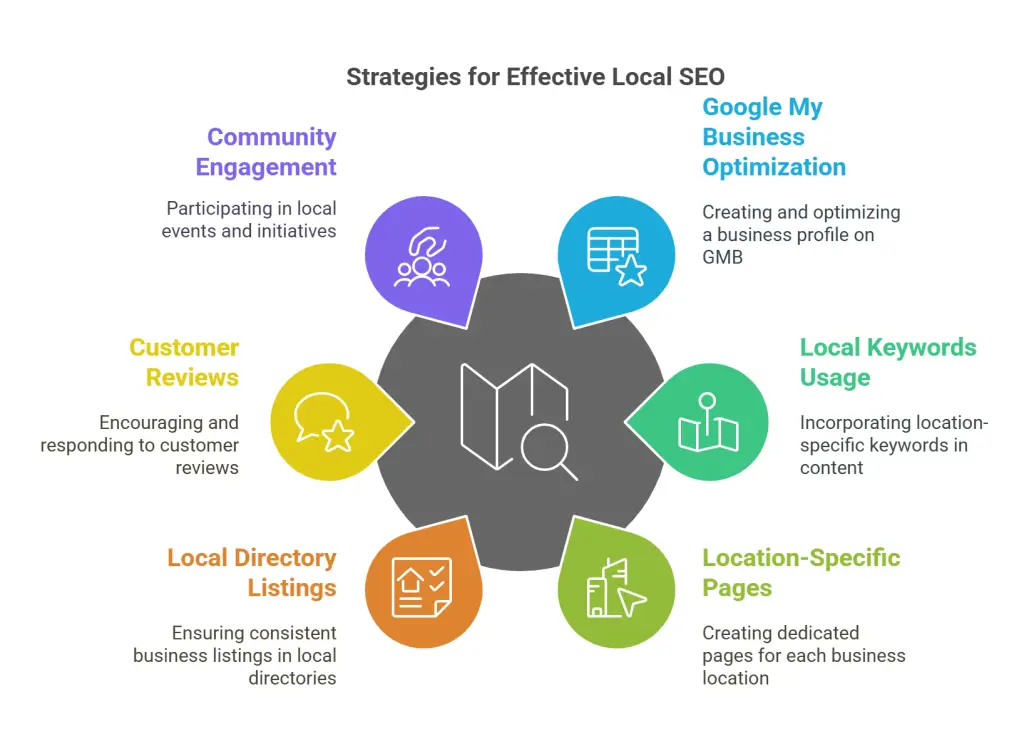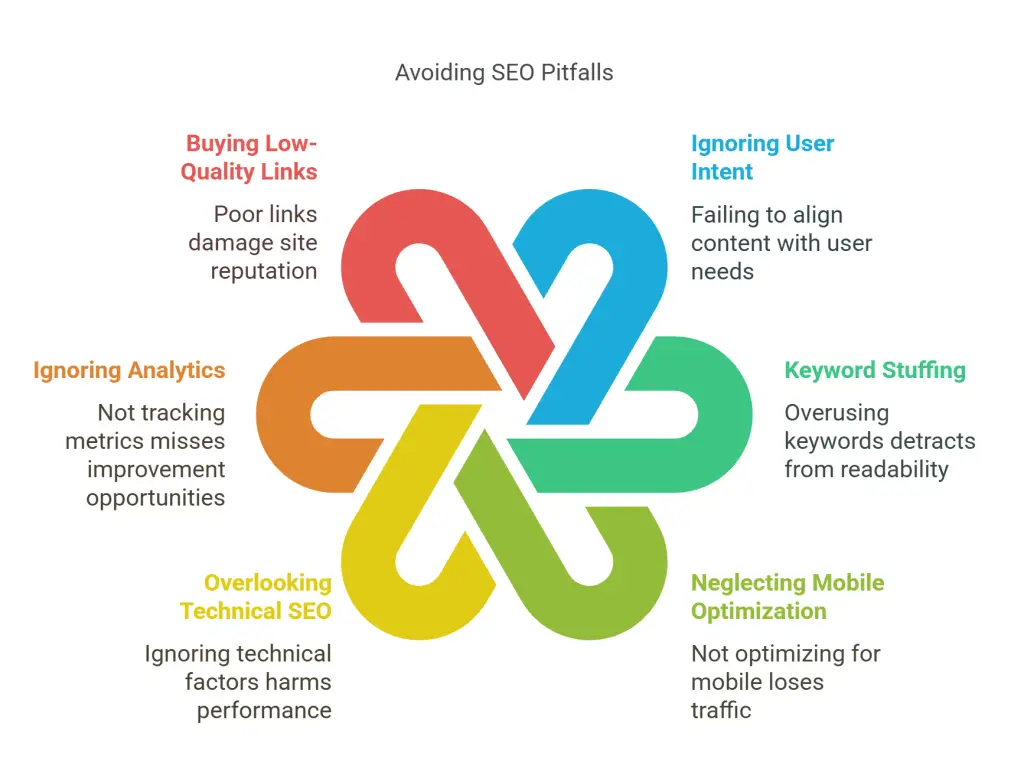Building a robust online presence is essential for businesses striving for success. Search Engine Optimization (SEO) is a pivotal aspect of digital marketing that can significantly improve your visibility on search engines, such as Google. This guide is designed to equip you with the expertise and resources required to master SEO, helping you boost traffic, increase your website’s ranking, and drive sales and business growth. By mastering SEO, you’ll gain the tools necessary to reach a larger audience, foster customer trust, and elevate your digital footprint.
What is SEO?
SEO, or Search Engine Optimization, is the practice of optimizing your website to increase its visibility on search engine results pages (SERPs). The goal is to improve organic (non-paid) traffic to your site by achieving higher rankings for relevant search queries. SEO involves various techniques, including keyword research, on-page optimization, technical SEO, and link building, all of which work together to enhance your site’s authority and relevance.

Why SEO Matters
- Increased Visibility: The higher your site ranks on search engines, the more likely users will find and visit it. Increased visibility leads to more traffic and potential customers.
- Credibility and Trust: Websites that rank highly on search engines are often perceived as more credible and trustworthy. Users tend to trust search engines and are more likely to click on the top results.
- Cost-Effectiveness: Unlike paid advertising, SEO focuses on organic traffic, making it a cost-effective long-term strategy. Once your site is optimized, it can continue to attract visitors without ongoing expenses.
- User Experience: SEO involves optimizing your website’s content and structure, leading to improved user experience and increased engagement.

Understanding How Search Engines Work
To effectively optimize your website for search engines, it’s essential to understand how they function. Search engines use complex algorithms to crawl, index, and rank websites. Here’s a brief overview of each process:
- Crawling: Search engines use bots, also known as spiders or crawlers, to scan the internet for content. These bots follow links from one page to another, discovering new content to add to their index.
- Indexing: Once a page is crawled, the search engine analyzes its content, structure, and metadata to understand what it’s about. The page is then added to the search engine’s index, a massive database of web pages.
- Ranking: When a user enters a search query, the search engine retrieves relevant results from its index and ranks them based on various factors, such as relevance, authority, and user experience.

Key Ranking Factors
Search engines consider numerous factors when ranking websites. Some of the most important ones include:
- Relevance: The content on your page should match the search query. Using relevant keywords and topics helps search engines understand your content’s subject matter.
- Authority: Search engines assess a site’s authority based on its backlink profile, which is the number and quality of links pointing to the site. High-quality backlinks from reputable sources signal trust and authority.
- User Experience: Factors like page load speed, mobile-friendliness, and ease of navigation impact user experience. Search engines prioritize sites that offer a seamless experience for users.
- Content Quality: High-quality, valuable content that provides answers to users’ questions and solves their problems is more likely to rank well.

Conducting Keyword Research
Keyword research is the foundation of any successful SEO strategy. It involves identifying the search terms and phrases your target audience uses when looking for products or services like yours. Here are the steps to conduct effective keyword research:
- Brainstorm Seed Keywords: Start by listing words and phrases related to your business, products, or services. These are your seed keywords.
- Use Keyword Research Tools: Tools like Google Keyword Planner, SEMrush, and Ahrefs can help you find relevant keywords with search volume and competition data.
- Analyze Competitors: Study your competitors’ websites to identify the keywords they’re targeting. This can provide insights into potential opportunities and gaps in your strategy.
- Focus on Long-Tail Keywords: Long-tail keywords are more specific phrases with lower search volume but higher conversion potential. They often reflect user intent more accurately.
- Prioritize and Select Keywords: Choose keywords based on relevance, search volume, and competition. Aim for a mix of high-volume keywords and less competitive long-tail keywords.

On-Page Optimization
On-page optimization involves optimizing individual web pages to improve their search engine rankings. It encompasses various elements, including content, HTML tags, and site structure. Here are some key on-page optimization techniques:
- Optimize Title Tags: The title tag is one of the most important on-page SEO elements. It should accurately describe the page’s content and include your target keyword. Keep it concise and compelling, ideally under 60 characters.
- Craft Meta Descriptions: Meta descriptions provide a brief summary of a page’s content and appear below the title in search results. Use them to entice users to click on your link by including a call-to-action and relevant keywords.
- Use Header Tags: Use header tags (H1, H2, H3, etc.) to structure your content and make it easier for search engines to understand. The H1 tag should contain the main keyword and reflect the page’s primary topic.
- Optimize Images: Use descriptive file names and alt text for images to help search engines understand their content. Compress images to improve page load speed.
- Include Internal Links: Link to relevant pages within your website to improve navigation and help search engines discover and index new content.
- Create High-Quality Content: Write informative, engaging, and valuable content that addresses your audience’s needs. Use keywords naturally and avoid keyword stuffing.

Technical SEO
Technical SEO focuses on optimizing the backend of your website to improve its visibility and performance. It ensures that search engines can easily crawl and index your site. Here are some key aspects of technical SEO:
- Ensure Mobile-Friendliness: With the increasing use of mobile devices, having a mobile-friendly website is crucial. Use responsive design to ensure your site looks and functions well on all devices.
- Improve Page Speed: Fast-loading pages provide a better user experience and are favored by search engines. Optimize images, minify CSS and JavaScript, and leverage browser caching to improve page speed.
- Use SSL Encryption: Secure Sockets Layer (SSL) encryption ensures a secure connection between your website and users. Sites with HTTPS are prioritized by search engines.
- Fix Broken Links: Regularly check for and fix broken links on your site. Broken links can hinder user experience and negatively impact SEO.
- Create an XML Sitemap: An XML sitemap helps search engines understand the structure of your site and discover new content. Submit your sitemap to search engines to improve indexing.
- Implement Structured Data: Use structured data (schema markup) to provide search engines with additional context about your content. This can enhance search results with rich snippets, improving click-through rates.

Off-Page Optimization
Off-page optimization involves activities outside your website that influence its search engine rankings. It primarily focuses on building a strong backlink profile. Here are some effective off-page optimization techniques:
- Build High-Quality Backlinks: Acquire backlinks from reputable and relevant websites. Focus on quality over quantity, as authoritative links carry more weight.
- Guest Blogging: Contribute high-quality content to other websites in your industry. This can help you gain exposure and earn valuable backlinks.
- Social Media Engagement: Actively engage with your audience on social media platforms. While social media signals are not direct ranking factors, they can increase brand visibility and drive traffic to your site.
- Online Directories and Citations: List your business in relevant online directories and ensure your NAP (Name, Address, Phone Number) information is consistent across platforms.
- Influencer Outreach: Collaborate with influencers in your industry to promote your content or products. Influencer endorsements can lead to increased brand awareness and backlinks.
- Content Promotion: Promote your content through various channels, including email newsletters, forums, and online communities. The more exposure your content gets, the more likely it is to attract backlinks.

Local SEO
Local SEO is essential for businesses targeting a specific geographic area. It involves optimizing your online presence to attract local customers. Here are some key strategies for local SEO:
- Optimize Google My Business (GMB): Create and optimize your GMB profile with accurate business information, photos, and customer reviews. Encourage satisfied customers to leave positive reviews.
- Use Local Keywords: Incorporate local keywords in your content, title tags, and meta descriptions to signal relevance to specific locations.
- Create Location-Specific Pages: If your business serves multiple locations, create dedicated pages for each area. Include local keywords and relevant information on each page.
- Get Listed in Local Directories: Ensure your business is listed in local directories and review sites. Consistent NAP information across platforms is crucial for local SEO.
- Encourage Customer Reviews: Positive reviews not only build trust but also influence local search rankings. Respond to reviews to show engagement and address any concerns.
- Engage with Local Communities: Participate in local events and sponsor community initiatives. This can enhance your local presence and generate valuable backlinks.

Measuring SEO Success
Measuring the success of your SEO efforts is crucial for understanding what’s working and what needs improvement. Here are some key metrics and tools to track your SEO performance:
- Organic Traffic: Monitor the number of visitors coming to your site from search engines. Tools like Google Analytics can help you track organic traffic trends over time.
- Keyword Rankings: Track your keyword rankings to see how your site performs for target keywords. Tools like SEMrush and Ahrefs can provide insights into your ranking positions.
- Backlink Profile: Analyze your backlink profile to assess the quality and quantity of links pointing to your site. Tools like Moz and Ahrefs offer comprehensive backlink analysis.
- Conversion Rate: Measure the percentage of visitors who complete desired actions on your site, such as making a purchase or signing up for a newsletter. A/B testing can help optimize conversion rates.
- Bounce Rate: Monitor the percentage of visitors who leave your site after viewing only one page. A high bounce rate may indicate issues with user experience or content relevance.
- Page Load Speed: Use tools like Google PageSpeed Insights to assess and improve your site’s loading speed.
- Mobile Usability: Check your site’s mobile usability using Google’s Mobile-Friendly Test. Ensure your site provides a seamless experience on mobile devices.

Common SEO Mistakes to Avoid
While SEO can significantly benefit your business, there are common mistakes that can hinder your efforts. Here are some pitfalls to avoid:
- Ignoring User Intent: Focusing solely on keywords without considering user intent can result in irrelevant content. Understand what users are looking for and tailor your content accordingly.
- Keyword Stuffing: Overloading content with keywords can lead to poor user experience and penalties from search engines. Use keywords naturally and prioritize readability.
- Neglecting Mobile Optimization: With the rise of mobile search, failing to optimize your site for mobile devices can result in lost traffic and rankings.
- Overlooking Technical SEO: Ignoring technical aspects like site speed, SSL, and structured data can negatively impact your site’s performance and rankings.
- Ignoring Analytics: Failing to track and analyze SEO metrics can lead to missed opportunities for improvement. Regularly review your data to make informed decisions.
- Buying Low-Quality Links: Acquiring links from spammy or irrelevant sites can harm your site’s reputation and rankings. Focus on earning high-quality, authoritative links.

SEO Trends to Watch
The SEO landscape is constantly evolving, with new trends and technologies shaping how businesses optimize their online presence. Here are some SEO trends to keep an eye on:
- Voice Search Optimization: With the rise of voice-activated devices, optimizing for voice search is becoming increasingly important. Focus on natural language and long-tail keywords.
- AI and Machine Learning: Search engines are leveraging AI and machine learning to improve search results. Understanding how these technologies impact SEO can give you a competitive edge.
- Video SEO: Video content continues to grow in popularity. Optimize videos with relevant keywords, descriptions, and transcripts to improve visibility on search engines.
- Core Web Vitals: Google emphasizes user experience through Core Web Vitals metrics, such as loading speed, interactivity, and visual stability. Ensure your site meets these standards.
- Mobile-First Indexing: Google primarily uses the mobile version of your site for indexing and ranking. Ensure your mobile site is fully optimized for SEO.
- Featured Snippets: Aim to capture featured snippets, which appear at the top of search results, by providing concise and valuable answers to common questions.

Conclusion
SEO is a dynamic and multifaceted discipline that requires continuous learning and adaptation. By understanding the fundamentals of SEO, conducting thorough keyword research, optimizing on-page and technical elements, and building a strong backlink profile, you can improve your website’s visibility and drive organic traffic. Stay updated with the latest SEO trends and best practices to maintain a competitive edge in the digital landscape. With dedication and the right strategies, you can unlock the full potential of SEO to grow your business and achieve lasting success.
Remember, SEO is a long-term investment, and results may not be immediate. However, by consistently implementing and refining your SEO efforts, you can build a strong online presence that attracts and retains customers. Embrace the challenges and opportunities that SEO presents, and watch your business thrive in the digital age.
Further reading
WebFX. “Master SEO: The Ultimate Guide to Search Engine Optimization.” Last accessed February 3, 2025. https://www.webfx.com/blog/seo/master-seo/.
HubSpot. “The Shortest Tutorial Ever on SEO (Search Engine Optimization).” Last accessed February 3, 2025. https://blog.hubspot.com/marketing/tabid/6307/bid/1436/shortest-tutorial-ever-on-seo-search-engine-optimization.aspx.
Google Developers. “SEO Starter Guide.” Last accessed February 3, 2025. https://developers.google.com/search/docs/fundamentals/seo-starter-guide#:~:text=SEO%E2%80%94short%20for%20search%20engine,site%20through%20a%20search%20engine.
Wikipedia. “Search Engine Optimization.” Last accessed February 3, 2025. https://en.wikipedia.org/wiki/Search_engine_optimization.
Business.gov.au. “Improve Your Search Engine Rankings.” Last accessed February 3, 2025. https://business.gov.au/online-and-digital/business-website/improve-your-search-engine-rankings.
Mailchimp. “SEO.” Last accessed February 3, 2025. https://mailchimp.com/marketing-glossary/seo/.
Search Engine Land. “What Is SEO?” Last accessed February 3, 2025. https://searchengineland.com/guide/what-is-seo.







